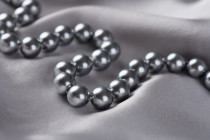
HOW TO FIND US
Robinson Jewelers
103 E. Butler Road
Mauldin, SC 29662
BUSINESS HOURS
Monday - Friday 10:00am - 5:00pm
Email: robinsonjewels@aol.com
Or fill out our contact form

Pearls are timless and classic
Cultured pearls
are created by stimulating an oyster or mussel to produce a pearl
Types of Pearls
- South Sea pearls are very rare. Exceptionally large, smooth, and
round, they may be white/cream,
golden, or black. They come from white-lipped oysters in the waters of Australia and Southeast Asia.
- Tahitian pearls, also known as black pearls, grow from the black-lipped oysters and this is where they get their color. They are cultivated exclusively in the volcanic atolls of Tahiti.
- Akoya pearls are the pearls that often come to mind when
people think of classic white pearls.
Cultured in saltwater mollusks in China and Japan, they look similar to freshwater pearls. Akoya pearls tend to be more lustrous and are larger.
- Freshwater pearls come in shades. Depending on the type of
mollusk that grows them,they are white to black in color. At a glance they strongly resemble Akoya pearls, but they are generally smaller and
less symmetrical and therefore less valuable.
Color
A pearl’s color is a
combination of two types of color: the body color and the overtone.
- Body color refers to a pearl’s primary color. Most people think
of white or cream-colored stones when
they think of pearls, but they appear in many other shades as well, such as pink, rose, silver, blue/gray, gold, and black.
- Overtone refers to secondary color; typically rose, pink, or
silver, that appears as light reflects
off the surface of a pearl.
Size
Size is not the only criteria to judge the quality of a pearl. In evaluating the pearl, if all other factors including color, luster, shape, and surface of the pearl, are the same, most likely the value of a particular pearl will be higher because of its size. Cultured pearl are measured in millimeters.
- South Sea and Tahitian pearls generally go up to 13 mm in size;
although, some as large as 20 mm
have been found.
- Akoya pearls average in size 6.0 to 8.5 mm.
- Freshwater pearls average in size 3.0 to 7.0 mm.
Luster
The luster refers to
a pearl’s shine, or the effect that is created when light is reflected off the
iridescent material which is called the nacre. The larger the pearl, the more nacre and the more luster. The
higher the luster, the more valuable the pearl.
- Very high to high are the grades of luster that refer to extremely
bright, sharp light reflections.
- Soft or dull is the grade that refers to weak or imprecise
reflections on the surface of the pearl.
It is characteristic of the lowest-quality pearls. - Medium grade is middle grade. Pearls at medium grade are cost less and the pearls graded very high or high in luster.
Shape
While pearls come in
several different shapes, round pearls are the most desirable. The rounder the
pearl, the higher the quality. A perfectly round pearl is extremely rare.
- Round is defined as a pearl whose rate of diameter varies by less than 2%.
- Semi-round pearls have a greater diameter variation than round pearls, but still less than 5%.
- Drop, button, pearl, and oval shaped pearls are called semi-baroque or
baroque pearls.
Semi-baroque pearls have an axis of rotation, which means you can actually spin
one on a tabletop.
Surface
The ideal pearl has a
smooth surface that is relatively free of blemishes, discoloration, or other
imperfections.
- Clean or very lightly blemished is the highest rating for the surface quality of a pearl. This quality is the most desirable of the pearls.
- Lightly or moderately blemished pearls are less desirable.
- Pearls that are heavily blemished are the least desirable.

